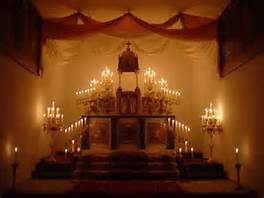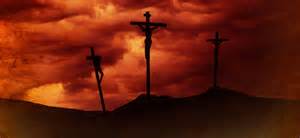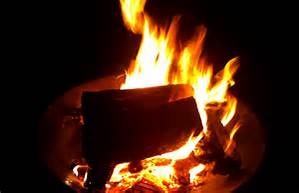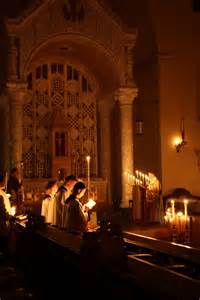
The first three days of Holy Week have a special contribution to the overall theme of the week
however the Church has placed greater emphasis on the last three days through more solemn services because it was on these days that the redemptive work of Christ was brought to completion.
![10569025_481032895414886_6964248776871166480_n[1]](http://www.magnificatmedia.com/wp-content/uploads/2016/03/10569025_481032895414886_6964248776871166480_n1.jpg) The first of the days, Holy Thursday, has received in the course of time a variety of names which serve to put in relief its special theme. From earliest times it has been called feria quinta in coena Domini, since it principally commemorates the institution of the Holy Eucharist. The same theme is brought out by the title given it in the Calendar of Polemius Silvius, namely, Natalis Calicis. To underline the idea that on this day our Lord was betrayed by His trusted disciple Judas and also began to offer Himself up for the sins of mankind, some called the day the dies traditionis. A common English name is Maundy Thursday, which is derived from the ceremony for washing the feet, called in Latin mandatum (commandment) and done in imitation of our Lord when He washed the feet of the Apostles , saying to them: “A new commandment I give to you, that you love one another….
The first of the days, Holy Thursday, has received in the course of time a variety of names which serve to put in relief its special theme. From earliest times it has been called feria quinta in coena Domini, since it principally commemorates the institution of the Holy Eucharist. The same theme is brought out by the title given it in the Calendar of Polemius Silvius, namely, Natalis Calicis. To underline the idea that on this day our Lord was betrayed by His trusted disciple Judas and also began to offer Himself up for the sins of mankind, some called the day the dies traditionis. A common English name is Maundy Thursday, which is derived from the ceremony for washing the feet, called in Latin mandatum (commandment) and done in imitation of our Lord when He washed the feet of the Apostles , saying to them: “A new commandment I give to you, that you love one another….
Besides commemorating the mystery of the Eucharist and the fraternal love which it should bring about, Holy Thursday was also the day on which two other ceremonies took place: the reconciliation of penitents and the consecration of Holy Oils. Our first witness to this union is the letter of Pope Innocent I to Decentius of Gubbio written at the beginning of the fifth century. And the old Gelasian Sacramentary provides special formulas for this ceremony. According to it, the reconciliation of penitents replaced the normal Foremass, as the following rubric states: “Eodem die non psallitur, nec salutat, id est non dicit Dominus vobiscum; et Reconciliatio.” After the penitents were reconciled, the Mass proper started with the Offertory. However, by the time of Gregory the Great this rite had already fallen into disuse, for there is no ceremony and no mention of the practice in the Gregorian Sacramentary.
We must also admit that the consecration of Holy Oils on this Thursday is appropriate, for it serves to emphasize the fact that all sacraments and blessings flow from the Eucharistic Sacrifice. However, the oils were not always blessed on this day. Though a special blessing for oil (apparently oil for the infirm) figures among the blessings provided for other natural products before the concluding doxology of the Canon of the Mass in the Apostolic Tradition, Chrism and the Oil for Catechumens were blessed in the early Church immediately before the conferring of Baptism. The first trace of all the oils being consecrated together during the Mass on Holy Thursday appears in the Gelasian Sacramentary.
In the liturgical books of the Roman Rite this day, Good Friday, is called Parasceve which  mean preparation. This is a day of great sorrow, dies amaritudinis, and this sorrow was expressed by fasting; this indeed was a universal custom. As another expression of this sentiment there existed a universal custom of not celebrating Mass on this day. In the seventh century some even went so far as to keep their churches closed, a practice which the Council of Toledo dubbed as an abuse. In time a discussion arose as to why no Mass was celebrated, since the days on which the saints died were kept as festivals. Helperich, a monk of Christ, unlike the saints, achieved no greater degree of glory through His death, for He died, not for His own sake, but for ours.
mean preparation. This is a day of great sorrow, dies amaritudinis, and this sorrow was expressed by fasting; this indeed was a universal custom. As another expression of this sentiment there existed a universal custom of not celebrating Mass on this day. In the seventh century some even went so far as to keep their churches closed, a practice which the Council of Toledo dubbed as an abuse. In time a discussion arose as to why no Mass was celebrated, since the days on which the saints died were kept as festivals. Helperich, a monk of Christ, unlike the saints, achieved no greater degree of glory through His death, for He died, not for His own sake, but for ours.
Once it had become traditional to hold some sort of liturgical service in public, it was always held in the afternoon hours. The earliest document tells us that the pope descended from his apartments at two o-clock. And this arrangement continued up to and including the first part of the fifteenth century. Just after that the ceremony was held in the morning, according to Burchard’s Ceremonial, complied in 1488. The restoration of this service to its appropriate hours in the afternoon is due to Pius XII.
Three parts make up the Liturgy of Good Friday: (a) a reading service similar to our Mass of the Catechumens, (b) the veneration of the cross, and (c) a communion service.
The entire first part is composed of reading, chants, and prayers. And this is nothing else than the ancient type of service held on days which were a-liturgical, that is, days on which the Eucharistic Sacrifice was not offered. It is the Service of the Word, originally taken over from the Jewish Sabbath synagogue service and united, no later than the second century, to the Eucharistic Sacrifice as the part known today as the Mass of the Catechumens.
 Even more so than Friday, Holy Saturday, is completely a-liturgical and traditionally so. Innocent I gives as the reason for no Eucharistic celebration on this day the tradition that the Apostles spent the day in grief over the loss of Christ. The Church keeps the day in quiet mourning, for her Bridegroom has been taken away from her and lies in the tomb. This is the theme of Matins for Holy Saturday: Christ’s death and burial, His lying in the tomb, the descent into Limbo.
Even more so than Friday, Holy Saturday, is completely a-liturgical and traditionally so. Innocent I gives as the reason for no Eucharistic celebration on this day the tradition that the Apostles spent the day in grief over the loss of Christ. The Church keeps the day in quiet mourning, for her Bridegroom has been taken away from her and lies in the tomb. This is the theme of Matins for Holy Saturday: Christ’s death and burial, His lying in the tomb, the descent into Limbo.
It is with the Easter Vigil that the real Easter Liturgy begins, and in which the entire liturgical year and Holy Week reach their climax. But why is the year’s climax reached only at night? According to the mind of the ancients, an important feast always began at the Vespers of the preceding evening. But on this evening the Church is not satisfied to rejoice simply with first Vespers; she spends the whole night in prayer, meditation, and exultation. She keeps vigil; she stays awake. As St. Augustine says of this “mother of all Christian vigils, we observe the night in which our Lord arose by watching; we contemplate the life in which there is no raising it up from the dead…Nor is it out of place for us thus to stay awake in vigil: for He slept that we might remain awake, He died that we might live.”
But this holy night is not simply commemorative of the past. In Baptism we have not  arisen to a purely earthly life; the grace which is the principle of our new life in Christ is also the seed of glory. We are called to live in the presence of God in heaven for all eternity. Although we have arisen with Christ to a new life of grace, we still await our ascension into heaven, the consummation of our hope.
arisen to a purely earthly life; the grace which is the principle of our new life in Christ is also the seed of glory. We are called to live in the presence of God in heaven for all eternity. Although we have arisen with Christ to a new life of grace, we still await our ascension into heaven, the consummation of our hope.
To learn more about Paschal Triduum, listen to Learning about the Roman Liturgy today, March 24th, 2016, with Louis Tofari on Magnificat Radio at www.magnificatmedia.com at 10am, 1pm, 5:30pm, and 10pm, CST, USA. Click LISTEN LIVE button. To purchase books and materials mentioned on Learning about the Roman Liturgy with Louis Tofari visit this link: Romanitas Press
